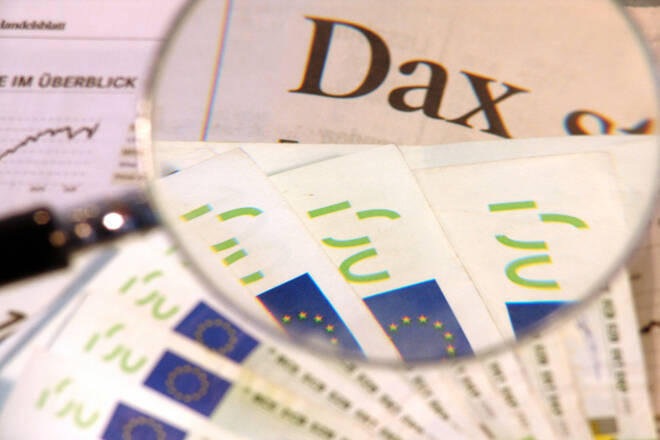Advertisement
Advertisement
DAX Index: DAX Eyes German Ifo Business Climate Index Amid Market Uncertainties
By:
Amid mixed signals from PMIs and potential ECB policy shifts, the DAX 30 and DAX stocks navigate through market volatilities.
Highlights
- DAX slipped 0.09% to close the Friday session at 15,557.
- German business sentiment figures for September will provide early direction today.
- However, US economic indicators and ECB President Lagarde will draw interest later in the Monday session.
DAX Friday Overview
On Friday, the DAX slipped by 0.09%. Following a 1.33% slide on Thursday, the DAX ended the day at 15,557.
Private Sector PMIs Send Mixed Signals
German and Eurozone private sector PMIs for September sent mixed signals on Friday. The PMIs from Germany beat forecasts, with the Eurozone composite also higher than expectations.
The German services PMI rose from 47.3 to 49.8, with the manufacturing PMI up from 39.1 to 39.8. In September, the Eurozone services PMI increased from 47.9 to 48.4, while the manufacturing PMI slipped from 43.5 to 43.4.
Despite the better-than-expected PMIs, investor sentiment toward higher for longer ECB interest rates weighed on buyer appetite.
A softer-than-expected US services sector PMI failed to ease bets on a hawkish Fed interest rate trajectory.
The US equity markets reacted to both the PMI numbers and the escalating threat of a US government shutdown. On Friday, the NASDAQ Composite Index fell by 0.09%, with the Dow and S&P 500 seeing losses of 0.31% and 0.23%, respectively.
The Friday Market Movers
Commerzbank was the worst performer on the DAX, tumbling by 3.44%. News of the bank planning on announcing its new strategy plans in November fueled the sell-off. In contrast, Deutsche Bank gained 0.20%.
German Ifo Business Climate Index in Focus
September German Ifo Business Climate Index numbers will draw investor interest today. Economists forecast the Ifo Business Climate Index to fall from 85.7 to 85.0.
While the headline figure will influence buyer appetite, investors must consider the sub-components. Economists expect the Current Assessment Index to decline from 89.0 to 88.0 but the Expectations Index to rise from 82.6 to 82.9.
A more favorable economic outlook would limit the impact of a softer headline figure.
While economic indicators will shape investor sentiment, investors should also closely monitor ECB commentary. ECB President Lagarde and ECB Executive Board member Isabel Schnabel are on the calendar to speak today. A move away from the higher-for-longer mantra would fuel buyer appetite.
Chicago Fed National Activity Index to Provide Late Direction
Late in the European session, the Chicago Fed National Activity Index will need consideration. A pickup in economic activity would support the more hawkish Fed interest rate path.
Economists forecast the Index to rise from 0.12 to 0.15 in August.
While the Index will influence investor sentiment, FOMC member commentary will also garner interest.
Short-Term Forecast
The higher-for-longer ECB mantra for interest rates remains a headwind. However, German economic indicators could offer much-needed support this week. A pickup in business sentiment toward the economic outlook and softer inflation numbers would send bullish signals.
DAX Technical Indicators
Daily Chart
The DAX remained below the 50-day EMA while holding above the 200-day EMA, sending bearish near-term but bullish longer-term price signals.
A fall through the 200-day EMA and the 15,459 support level would give the bears a look at sub-15,300. An unexpected slide in the German Ifo Business Expectations Index would weigh on buyer appetite. Buyer appetite will intensify at 15,470. The 200-day EMA is confluent with the 15,459 support level.
However, a break above the 15,663 resistance level would support a DAX move toward the trend line. Less hawkish ECB comments and softer-than-expected US economic indicators would give the bulls a run at 15,800.
The 14-Daily RSI reading of 40.98 supports a DAX break below the 200-day EMA and 15,459 support level before entering oversold territory.
4-Hourly Chart
The DAX, remaining below the 50-day and 200-day EMAs, reaffirms bearish price signals. A DAX fall through the 15,459 support level would bring sub-15,300 into play.
However, a break above the 15,663 resistance level would support a DAX move to the 50-day EMA.
The 37.59 RSI reading indicates a DAX break fall through the 15,459 support level before entering oversold territory.
For a look at the economic events, check out our economic calendar.
About the Author
Bob Masonauthor
With over 28 years of experience in the financial industry, Bob has worked with various global rating agencies and multinational banks. Currently he is covering currencies, commodities, alternative asset classes and global equities, focusing mostly on European and Asian markets.
Advertisement
